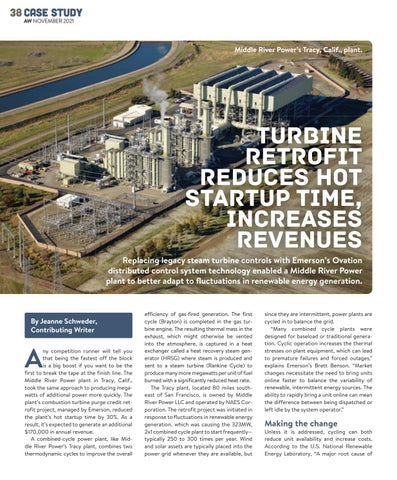38 CASE STUDY AW NOVEMBER 2021
Middle River Power’s Tracy, Calif., plant.
Turbine Retrofit Reduces Hot Startup Time, Increases Revenues
Replacing legacy steam turbine controls with Emerson’s Ovation distributed control system technology enabled a Middle River Power plant to better adapt to fluctuations in renewable energy generation.
By Jeanne Schweder, Contributing Writer
A
ny competition runner will tell you that being the fastest off the block is a big boost if you want to be the first to break the tape at the finish line. The Middle River Power plant in Tracy, Calif., took the same approach to producing megawatts of additional power more quickly. The plant’s combustion turbine purge credit retrofit project, managed by Emerson, reduced the plant’s hot startup time by 30%. As a result, it’s expected to generate an additional $170,000 in annual revenue. A combined-cycle power plant, like Middle River Power’s Tracy plant, combines two thermodynamic cycles to improve the overall
2111_F2.indd 38
efficiency of gas-fired generation. The first cycle (Brayton) is completed in the gas turbine engine. The resulting thermal mass in the exhaust, which might otherwise be vented into the atmosphere, is captured in a heat exchanger called a heat recovery steam generator (HRSG) where steam is produced and sent to a steam turbine (Rankine Cycle) to produce many more megawatts per unit of fuel burned with a significantly reduced heat rate. The Tracy plant, located 80 miles southeast of San Francisco, is owned by Middle River Power LLC and operated by NAES Corporation. The retrofit project was initiated in response to fluctuations in renewable energy generation, which was causing the 323MW, 2x1 combined cycle plant to start frequently— typically 250 to 300 times per year. Wind and solar assets are typically placed into the power grid whenever they are available, but
since they are intermittent, power plants are cycled in to balance the grid. “Many combined cycle plants were designed for baseload or traditional generation. Cyclic operation increases the thermal stresses on plant equipment, which can lead to premature failures and forced outages,” explains Emerson’s Brett Benson. “Market changes necessitate the need to bring units online faster to balance the variability of renewable, intermittent energy sources. The ability to rapidly bring a unit online can mean the difference between being dispatched or left idle by the system operator.”
Making the change
Unless it is addressed, cycling can both reduce unit availability and increase costs. According to the U.S. National Renewable Energy Laboratory, “A major root cause of
10/27/21 1:11 PM








